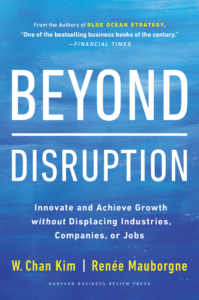 When thinking about innovation, the economic and social impact of the approach is not all that matters. What also matters is an organization’s ability to successfully implement it.
When thinking about innovation, the economic and social impact of the approach is not all that matters. What also matters is an organization’s ability to successfully implement it.
Our concept of nondisruptive creation is about innovating without destroying. It’s the flipside of disruption, where destruction is necessary to create.
While nondisruptive creation may appear more challenging, it has its own business advantages versus disruption, which stem from four sources. While the four sources of advantages may not all apply in every case of nondisruptive creation, the majority will.
The four sources of advantage include:
- The ability of an industry entrant to bypass big, incumbent players with significant resources and reach in their innovation efforts;
- The ability of an incumbent to respond to a full-on disruptive threat without confrontation;
- The responses of internal stakeholders to innovation efforts (nondisruptive creation is emotionally and politically easier for them to get behind); and
- The responses of external stakeholders to innovation efforts (nondisruptive creation largely sidesteps conflicts with social interest groups and governments).
- Let’s dive into one now and explain why it should matter.
Avoiding Direct Confrontations with Established Incumbents
There’s been a long love affair between Silicon Valley and disruption. Consider Mark Zuckerberg’s original motto for Facebook: “Move fast and break things.”
Not surprisingly, the hope of many startups — and established companies — is to disrupt an existing industry and become the next unicorn. But when a company sets out to disrupt an industry, it should prepare to confront well-entrenched organizations with deep network, financial and marketing resources, which, in the case of startups, will almost certainly tower over those of their own.
Consider the experience of MoviePass, which set out to disrupt the movie theater industry. In 2017, it launched a disruptive strike on the industry with a subscription model that allowed users to watch an unlimited number of movies per month at the unbelievable price of $9.99 a month — essentially the cost of one adult ticket. Within a year, its subscriber base skyrocketed to approximately 3 million.
Theater owners felt threatened and set out to fight. AMC, the largest U.S. movie chain, shut its theater doors to MoviePass subscribers, truncating the service’s reach. It then attacked MoviePass’s jugular with its own subscription service, called AMC Stubs A-List, and the other big theater chains, such as Regal and Cinemark, soon followed suit.
With the biggest chains now offering attractive terms that it couldn’t match, such as early ticket purchases, MoviePass ran out of money and was forced to shut down its subscription service in September 2019.
Consider the vastly different experience of Square. While the payment processing industry focused on serving large and medium-sized merchants, self-employed individuals and microbusinesses such as farmers’ market vendors were shut off from accepting credit card payments.
Seeing this untapped opportunity outside the credit card industry, Square set out to seize it. Its solution was a mobile payment system, the Square Reader, made for small businesses, pop-up shops and individuals to accept credit card payments.
Unlike MoviePass, Square’s nondisruptive move created but did not destroy. It caused little if any disruption to the existing payment processing industry. As a result, Square was able to grow quickly into a billion-dollar company without facing any real backlash from established players, who never felt threatened.
By setting aside the preconception that disruption is the way, and thinking in terms of nondisruptive creation, one becomes a sharper observer of nondisruptive opportunities lurking on the horizon that would sidestep rather than take on established players, providing new avenues for economic growth.
If disruption drives your thinking, ask yourself what nondisruptive opportunities might you be missing?
Recent Nondisruptive Innovations
| Company | Valuation |
|---|---|
| 23andMe: DTC genetic testing that helps understand ancestry & disease without displacing geneticists or hospitals. | $1B+ current valuation |
| Kickstarter: Public-idea financing without displacing investors or financial institutions. | Created ~300K+ jobs, 8K+ companies and $5.3B+ of direct economic impact |
| Esports: Reimagined gaming as an active and physical in-person sport and is now even an OLYMPIC event without displacing gaming creators or distributors. | Industry worth $1B+ with an estimated 175M+ global fans |
 W. Chan Kim and Renée Mauborgne are professors of strategy at INSEAD and co-directors of the INSEAD Blue Ocean Strategy Institute in Fontainebleau, France. Among numerous recognitions, they were named in 2011 the most influential management thinkers in the world by Thinkers50.
W. Chan Kim and Renée Mauborgne are professors of strategy at INSEAD and co-directors of the INSEAD Blue Ocean Strategy Institute in Fontainebleau, France. Among numerous recognitions, they were named in 2011 the most influential management thinkers in the world by Thinkers50.
Their most recent book is BEYOND DISRUPTION: Innovate and Achieve Growth without Displacing Industries, Companies, or Jobs (Harvard Business Review Press; May 2, 2023).
They are also authors of the global bestseller Blue Ocean Strategy, which has sold more than four million copies and has been recognized as one of the most iconic and impactful strategy books ever written, and Blue Ocean Shift, the New York Times, Wall Street Journal, USA Today and Los Angeles Times bestseller. To date, Blue Ocean Strategy and Blue Ocean Shift teaching materials have been adopted by more than 2,800 universities across the globe.
Kim and Mauborgne have written for the Wall Street Journal, the New York Times, the Financial Times and Harvard Business Review, as well as respected academic journals. They are the recipients of numerous academic and management awards, including the Nobels Colloquia Prize for Leadership on Business and Economic Thinking, the Carl S. Sloane Award by the Association of Management Consulting Firms, the Leadership Hall of Fame by Fast Company, and the Eldridge Haynes Prize for the best original paper by the Academy of International Business, among others.